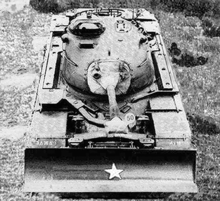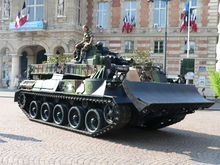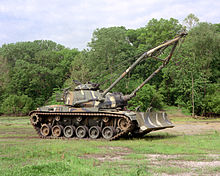Engineer tanks
Pionierpanzer (abbr .: AEV; Swiss: Genie tanks ) are armored tracked vehicles of the pioneers (Swiss: Genie troops). They serve to pave the way for the fighting troops, to overcome obstacles, to remove or to clear them. Furthermore, her tasks include creating coverings , as well as recovery and crane work. In order to be able to meet these requirements, they are equipped with the necessary special devices.
Since the armies of the different countries sometimes have completely different demands on the device, there are serious differences within the only small category of engineer tanks. Only the component “ earth movement ” is the same for all of them .
armed forces
Clearing armor
When conceived under construction Bundeswehr the Armored Engineer were companies initially with a vehicle held by the US Army equipped. It was the "Räumpanzer"; an M48A2 main battle tank , which was equipped with a clearing blade at the front that had to be operated by the driver. Only rough work could be done. The designation for this vehicle was: M48A2DB (DB - Dozer blade), then M48RPz in the Bundeswehr and finally M48A2CR without cannon.
Engineer tank 1
Successor models
At the end of the seventies work began on developing an improved successor. Two prototypes of the armored engineer machine (GPM) were produced on the chassis of the "Leopard-1 family".
- GPM 1 MAK (mechanical engineering Kiel)
- Frame arm kink bagger on a turret (similar to a battle tank tower ), pivoting range 360 °
- Arrangement of the commander and excavator operator in the tower as with the battle tank commander and loader
- divisible dozer blade with cutting angle adjustment
- Recovery winch for 35 t
- Weight 55 t max
- For weight reasons, the engine cover plate was made of aluminum.
- Since the excavator shovel could reach under the chain from the side, it was theoretically possible to knock the vehicle over on one's own.
- GPM 2 EWK (Eisenwerke Kaiserslautern)
- 2 telescopic arm excavator with turntables left and right in front, excavator arms placed to the rear, swivel range 195 ° each.
- Crew room in between (driver in front, operator behind, commander behind ), operation of the right excavator by the driver, the left excavator by the operator, who could also operate both excavator arms and thus override the driver.
- Dozer blade with cutting angle adjustment.
- Recovery winch for 35 t
- Weight 57 t max.
- The units were operated here via indirectly manually / hydraulically controlled valves. (so-called pilot operated valves.)
- Driving backwards (with the help of the telescopic excavator arms) inclines of 85% could be overcome.
Since the vehicles were far too heavy and therefore hopelessly underpowered and the hydraulic system too complicated, as well as because of the escalating costs, the project was discontinued.
The decision was then made in favor of the Dachs pioneer tank as its successor, which is not a new development, but an improvement on the previous concept.
Other armies
During the active period of Pionierpanzer 1 the other possessed NATO - armies on the following Pionierpanzer:
Armée française de terre
- EBG (Engin Blindé du Génie) based on the AMX 30 B2 battle tank
- Length: 8.29 meters
- Width: 3.35 meters
- Weight: 31000 kg
- Fuel supply: 990 liters for approx. 500 km on the road or 16-18 hours of work
- Crew: 3 men
- Gradeability: 60%
- possible bank slope: up to 30%
- Ground clearance: 45 centimeters
- Clearance capacity: approx. 200 m³ / h
- Dozer blade and foldable 15-ton telescopic crane arm with claw gripper (trunk gripper)
- Earth auger
- Cable winch: 35 t pulling capacity, 80 meters cable length
- Mine thrower for anti-tank mines (Mine antichar dispersable - AC DIS Mle F1)
- 20 mines on board (throwing distance up to 260 meters)
- Mortar for 10 kg explosive charges (Canon de demolition 10 kg d'explosif)
- 5 loads on board (throwing range 30-550 meters)
- Machine gun 7.62 mm
- Auxiliary engine for hydraulic system
- expected to be in service until 2020–2025
US Army
- M728 CEV (Combat Engineer Vehicle)
- Tower and hull of the M 60 main battle tank with an “A” crane boom with a load capacity of 15 t attached to the tower
- Hydraulic dozer blade on the front
- Length: 8.64 m
- Width: 3.60 m
- Height: 3.26 m
- Weight: 54 t
- Max road speed: 48 km / h
- Armament: 1 petard 165 mm (mortar) for 30 kg loads, range of fire 1000 m
- 1 machine gun 12.7 mm Browning M2 in commander's cupola
- 1 M60 machine gun , coaxial
- Development and production: 1960 first prototype as T 118 with the hull of the T-95 prototype main battle tank
- Troop attempt: 1966
- Introduced: 1967
- No longer in service with the US Army.
- M9 AEV (Armored Engineer Vehicle) (Also known as "Armored Combat Earthmover")
- Just an armored bulldozer with a bed behind the dozer blade. (A kind of armored wheelbarrow)
- Length: 6.25 m
- Width: 3.10 m
- Height: 2.70 m
- Weight: 15 to
- Engine power: 195 PS (diesel)
- In 1963 the US Army requested a new vehicle as a Universal Engineer Tractor . Developments by International Harvester as UET and Caterpillar as UETA. After troop trials, the machine was selected by International Harvester. It was intended to replace a conglomerate of existing multipurpose pioneering machines. The development was made more difficult by multiple changes to the originally required specifications. The vehicle is air transportable in the C-130 Hercules (and larger).
- Introduced: 1977
- Crew: 1
- Armament: smoke thrower
- ABC protected
- 2018 still in service (an increase in combat value is carried out)
British Army
- Combat Engineer Tractor FV 180 1976 to 2010
- Trojan (AVRE) since 2007.
- Terrier Armored Digger since 2010
Spanish armed forces
- ALACRÁN CZ 10/25 E.
After the introduction of the Leopard 2 as the main battle tank, some of the now redundant and no longer required M60 battle tanks were converted into pioneer tanks in Spain . The cannon was removed and a hydraulic excavator was attached to the cannon mantlet . In the driving position, this excavator arm is placed on the motor plate. The front of the vehicle was also equipped with a clearing blade. The crew consists of two men, the technical data such as dimensions and driving characteristics are still the same as for the M60A3.
People's Liberation Army
Indian armed forces
- AERV : based on the BMP-2 infantry fighting vehicle
Eastern bloc states
The Warsaw Pact and the military technically ajar, neutral States enjoy after the Second World War, initially nothing forge armor would have met. The existing at this time Bergepanzer T-55T (in the GDR armored tractor , in the CSSR VT-55A ) have been prepared by the NVA converted the GDR in own contribution to a crane tank named T-55TK and, if known, used only there . The vehicle first appeared in 1970 and was referred to by NATO as ACR (Armored Crane Vehicle). This development became necessary because the desired procurement of the IMR could not be realized and these vehicles were used as replacements.
- Technical equipment:
- a front clearing and support shield and a rear spur
- a crane that can be rotated through 360 ° on the left (the capacity of the crane is given as sufficient for a tower hoist , is 20 t)
- a winch with a single pulling force of 25 tons
From the beginning of the 1970s, the troops of the Eastern Bloc then had a pure engineering tank for the first time. From Soviet production, the IMR (Inschenernaya Maschina Rasgraschdenija ) appeared on the chassis of the T-55. This vehicle was equipped with a crane arm with a log grapple and a large adjustable blade with a surface sliding shoe. The shield could be operated in three positions. V-shaped, straight and sloping. The surface sliding shoe prevented undercutting during leveling work or when clearing snow. The crane arm was attached to an armored rotating turret, which was mounted in place of the combat tower. For transport, the crane arm was placed backwards in a frame and the gripper was attached to a device at the rear, the shield is folded back onto the tub bow.
- Dimensions:
- Maximum width over the dozer blade: 3.48 meters
- Maximum length of the blade tip to the end of the crane boom: 10.60 meters
- Maximum height to the crane arm in place: 3.37 meters
The IMR-2 was introduced in the early 1980s. He took over the pioneering construction of the IMR on a T-72 chassis. Those in charge of the Soviet Army wanted to turn the IMR into a universal vehicle, which is why it was equipped with KMT-R and PU mine clearance equipment. The KMT-R is based on the KMT-4. With the 2 PU devices, mine clearance charges could be fired, which were attached to the chain covers in wooden boxes on the sides of the engine compartment. The grab could be exchanged for an excavator shovel. The vehicle was equipped with a 7.62 mm machine gun. The IMR-2M was presented in the mid-1980s. The hydraulic system was better protected against damage, the mine clearing equipment PU and the MG were removed. The experience with the use of the IMR in eliminating the consequences of the reactor accident in Chernobyl led to the development of a remote-controlled variant of the IMR-2.
In 2008 the IMR-3 was presented. The pioneering body is now mounted on a T-90 chassis. In the current version IMR-3MA there is a 12.7 mm MG and a mine clearance device on the vehicle.
In Poland, the MID / MID-M is built on the basis of the license-built T-72 and its further development PT-91. It has an adjustable shield. It can be operated in a straight or swept position. A crane arm is attached to the right side of the tub bow. It has a gripper that can be exchanged for an excavator bucket. The vehicle is equipped with a winch. An exit tube can be added for salvage work underwater.
Web links
- http://web.archive.org/web/20130604171742/http://www.army.mod.uk/royalengineers (English)
- http://www.genie-militaire.com/ (French)
- http://www.defense.gouv.fr/ (French)
- http://www.fas.org/man/dod-101/sys/land/index.html (English - for US Army)
- http://www.panzerbaer.de/types/bw_pipz_1_standard-a.htm
- http://uralvagonzavod.com/products/special_products/2/
- http://www.obrum.gliwice.pl/test-content1/nowoczesne-pojazdy-pancerne/gasienicowe-pojazdy-inzynieryjne/midmid-m/
literature
- FM by Senger and Etterlin : Tanks of the World 1983 . Arms and Armor Press, London 1983, ISBN 0-85368-585-1 .
- BMVg 1960, technical service regulation Räumpanzer M 48 part 22 .
- BMVg 1974, preliminary. Technical Service Regulations Armored Engineer Machine. GPM 1 and GPM 2, part 22 .












